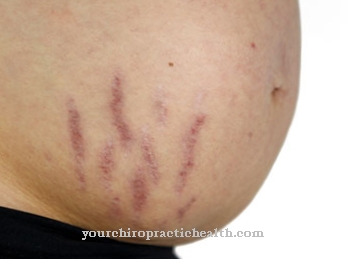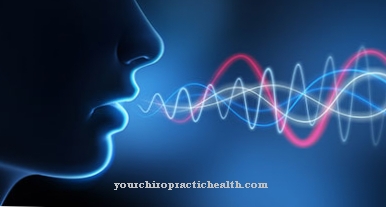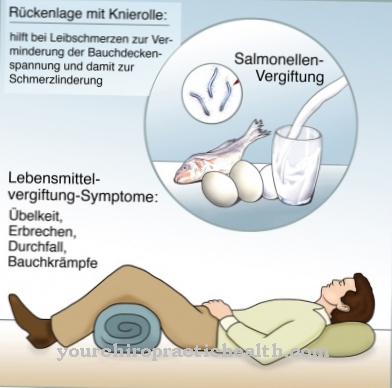The Chorea minor, also known as Sydenham's chorea, is an autoimmune neurological disease that usually occurs a few weeks after an infection with group A ß-hemolytic streptococci. The disease is usually a late manifestation of rheumatic fever.
What is Chorea Minor?

© Dron - stock.adobe.com
The chorea always arises from an impairment of the basal ganglia. Involuntary and sudden movements of the legs, arms, face, torso and neck are typical of chorea. The movements occur at rest and while performing voluntary movements. The term chorea comes from the Greek "choreia". The term used to describe the dances of the madmen.
The chorea minor was also called the St. Vitus dance in the Middle Ages. Minor chorea is one of the most common forms of chorea. Since minor chorea is a possible form of manifestation of rheumatic fever, it is also called chorea rheumatica or chorea infectiosa. The disease mainly affects six to thirteen year old girls. In rare cases, adults up to 40 years of age also get the disease.
causes
Chorea minor is an autoimmune disease that occurs a few days to weeks after a strep infection. Typical streptococcal infections can be found in the throat and pharynx area. During this infection, the body makes antibodies against the pathogen. However, these incorrectly react not only to the streptococci, but also to the body's own tissue. The surface structure of some body tissues is similar to that of streptococci.
Thus the antibodies attack the body's own cell structures. This causes the so-called rheumatic fever to develop. In addition to the cells of the heart, the basal ganglia in the brain are also attacked. 10 to 15 percent of all patients with rheumatic fever develop chorea minor. The basal ganglia lie below the cerebral cortex. The nuclei or core areas play an important role in motor, cognitive and limbic regulation.
They are an essential part of the extrapyramidal motor system (EPMS). In contrast to Huntington's disease, with chorea minor the basal ganglia are not irreversibly destroyed, but only temporarily impaired. Due to the inflammatory reactions, the movement-inhibiting basal ganglia are limited in their function. The movement-promoting basal ganglia in the substantia nigra and in the pallidum are partially disinhibited. This creates the characteristic excessive movements. The more cells in the basal ganglia have been damaged and the greater the inflammation in the brain, the more pronounced the symptoms.
You can find your medication here
➔ Medicines for fever and chillsSymptoms, ailments & signs
The movement disorders that occur in the context of chorea minor belong to the extrapyramidal hyperkinesias. They are similar to the symptoms of major chorea. So-called hyperkinesia occurs. Hyperkinesias are short-term, uncoordinated and uncontrollable muscle twitches of the arms, legs, feet and hands. These movements often go unnoticed at first. In school, the affected children fail due to poor typeface.
They appear clumsy, drop objects more often or can no longer eat properly with a knife and fork. Hyperkinesia also occurs in the facial muscles. The children make faces without even realizing it. The hyperkinesia of the throat muscles leads to difficulty speaking and swallowing. Because of the uncoordinated muscle twitching, those affected speak jerkily (dysarthria).
They often choke on themselves (dysphagia) and run the risk of so-called aspiration pneumonia. In aspiration pneumonia, inflammation develops from various substances that get into the lungs with saliva. The flycatcher or chameleon tongue is also characteristic of chorea minor.
Twitches in the tongue muscles cause the tongue to involuntarily stretch out and suddenly withdraw. The hyperkinesias increase with emotional stress and in stressful situations. As the affected children are often ashamed of these symptoms, they try to suppress the movements as much as possible. In addition to hyperkynesia, however, muscle hypotonia can also develop.
The children no longer have any strength in their muscles and react with weakened muscle reflexes. Psychological disorders such as attention disorders, fatigue, apathy, irritability, restlessness and, in rare cases, psychoses can also occur in the context of chorea minor.
Diagnosis & course
The clinical picture with the movement disorders typical of chorea provides first indications of the minor chorea. The anamnesis also shows typical indications. Mostly these are school-age children who have previously had tonsillar angina. There are increased inflammatory parameters in the blood.
The rate of sedimentation is increased, as is the CRP value and the white blood cell count. The anti-streptolysin titer in the blood is also increased. The increased ASL titer reflects a previous streptococcal infection. The positron emission tomogram shows an increased sugar metabolism in the striatum of the brain. In addition to minor chorea, there are usually other symptoms of rheumatic fever.
The so-called major criteria according to the Jones standard include heart inflammation, acute inflammation of the joints, rheumatic erythema or rheumatic lumps under the skin.
Complications
In most cases, chorea minor disrupts movement. Above all, uncontrollable and also uncoordinated movements occur. These can spread to the legs, feet, and arms. For outsiders, these movements seem bizarre and incomprehensible, which can lead to social problems.
Often the patient does not notice these movements himself. Children are also affected by these movements and can become victims of bullying and teasing. In children, chorea minor has a negative effect on writing, in particular. The use of ordinary objects such as knives and forks is also difficult, and the person concerned often appears clumsy.
This restricts the patient's everyday life. Aspiration is also possible, which in the worst case can be fatal. Hyperkinesis and disorders of concentration occur especially in stressful situations. The treatment is carried out by giving penicillin and in most cases it is successful.
However, penicillin must still be taken after the treatment in order to prevent secondary damage. In the case of psychological complaints, visits to the psychologist or appropriate medication are possible, which also do not lead to further complications.
When should you go to the doctor?
If the symptoms of chorea minor or chorea Sydenham occur, it is a neurological autoimmune disease that requires treatment. The secondary disease caused by streptococci usually arises after a rheumatic fever or tonsillitis. The resulting movement disorders are similar to those of Huntington's disease. In contrast to this hereditary disease, the movement disorders or hyperkinesis in chorea minor do not exist for life, but acutely.
Most people with rheumatic chorea or infectious chorea are children under 15 years of age. A doctor's visit is therefore essential. Because the chorea minor leads to inflammation in the brain and damage to the so-called basal ganglia. Swallowing disorders can lead to beverages and food components being inhaled into the lungs. That can be fatal. The symptoms of minor chorea are often not properly assigned. The affected children often compensate or suppress them.
If you suspect that something may be wrong after a rheumatic fever or tonsillitis, a doctor should be consulted. This will do everything possible to examine the blood for inflammation parameters and an increased white blood cell count. The sugar metabolism in the brain can be checked with a positron emission tomogram. It is necessary to search for major criteria such as acute inflammation of the joints, heart inflammation, rheumatic erythema or rheumatic skin lumps. Treatment with penicillin is effective.
Doctors & therapists in your area
Treatment & Therapy
The therapy is similar to the treatment for rheumatic fever. The patients receive high doses of penicillin for ten days. This is to eliminate the remaining streptococci. Cortisone is administered to reduce inflammation. Those affected also take salicylates for six to twelve weeks. If necessary, the psychological symptoms can be treated with sedatives. In rare cases, neuroleptics are used.
Outlook & forecast
The chorea minor has a good prognosis. In most patients the course of the disease is reversible. In rare cases, however, there are lifelong impairments or consequential damage due to the disease.
With adequate medical care, most patients with a diagnosed chorea minor can be completely cured. The functionality of the basal ganglia can be fully restored during therapy, as these are not permanently damaged in the case of chorea minor. You are subject to temporary impairment as it is a curable inflammation.
If the cause is treated, patients have the prospect of a life without sequelae or residual disorders. Over 90% of the sick show a recovery after about 2-3 months of medical treatment. Within an average of 4-5 months from the start of treatment, all symptoms gradually regress until the symptoms are completely free.
The healing time depends on the severity. It lasts longer, the more cells in the basal ganglia have been affected and the greater the inflammation in the brain. 10% of the patients suffer residuals in the further course despite the good healing vision. This leads to sequelae such as inner restlessness, psychomotor problems or a new relapse. The relapses occur despite the use of prophylactic examinations and treatments.
You can find your medication here
➔ Medicines for fever and chillsprevention
After suffering from illness, patients receive benzathine penicillin monthly for a period of five years. Without this prophylaxis, severe relapses occur in half of all cases. To prevent further infection, chronic sources of strep infection, such as enlarged tonsils or carious teeth, should be eliminated.
Aftercare
In the case of chorea minor, there are usually few or no follow-up measures and options available to those affected. In any case, early detection of the disease must take place so that there are no further complications or complaints. The earlier a doctor is contacted in the case of chorea minor, the better the further course of this disease is usually.
The person concerned should therefore consult a doctor at the first symptoms or signs. The treatment of chorea minor is mostly done by taking medication. Since antibiotics are mainly taken, they should not be taken with alcohol. The patient should also ensure that it is taken regularly with the correct dosage to completely relieve the discomfort.
Furthermore, if you have any questions or are unclear, you should always consult a doctor first. Since chorea minor can also lead to psychological complaints, medication can also be taken to alleviate these complaints. However, conversations with your own family or friends are also very helpful. The chorea minor usually does not have a negative impact on the life expectancy of the person affected if it is treated in a timely and correct manner.
You can do that yourself
In everyday life, the person concerned can make sure that he is paying attention to a stable immune system through his lifestyle. With a balanced diet, vitamin-rich food and regular exercise, he can strengthen his organism and maintain his health.
If enough minerals and trace elements are absorbed through food, the organism can quickly mobilize defenses against invading germs. This reduces the risk of illness and at the same time shortens the healing time in the event of illness. The hydration should be monitored and should be approximately two liters per day for an adult human.
In times of increased risk of infection, regular washing of your hands can prevent infection. In cold temperatures, the neck and head should be adequately covered. If there are dental problems, they should be treated by a doctor as soon as possible. As a preventive measure, professional teeth cleaning can be carried out regularly and teeth should be brushed after meals. This reduces the risk of developing tooth decay.
At the same time, the consumption of harmful substances or toxins must be avoided. The consumption of alcohol or nicotine weakens the organism and makes it vulnerable. For sufficient regeneration after stress or physical exertion, regular breaks and rest phases should be taken. In addition, the sleeping conditions must be adapted to optimal needs.


.jpg)
.jpg)








.jpg)



.jpg)










.jpg)
